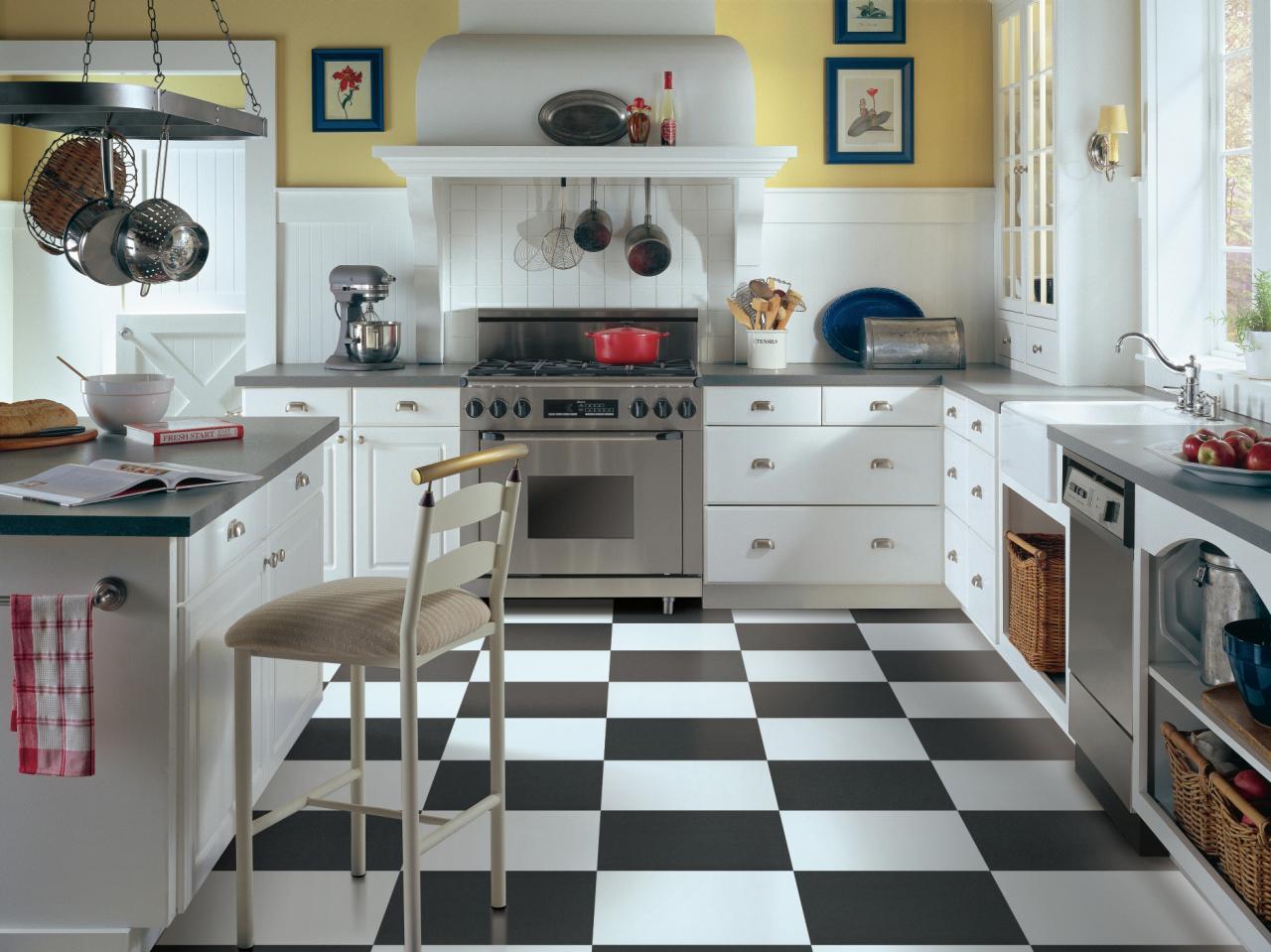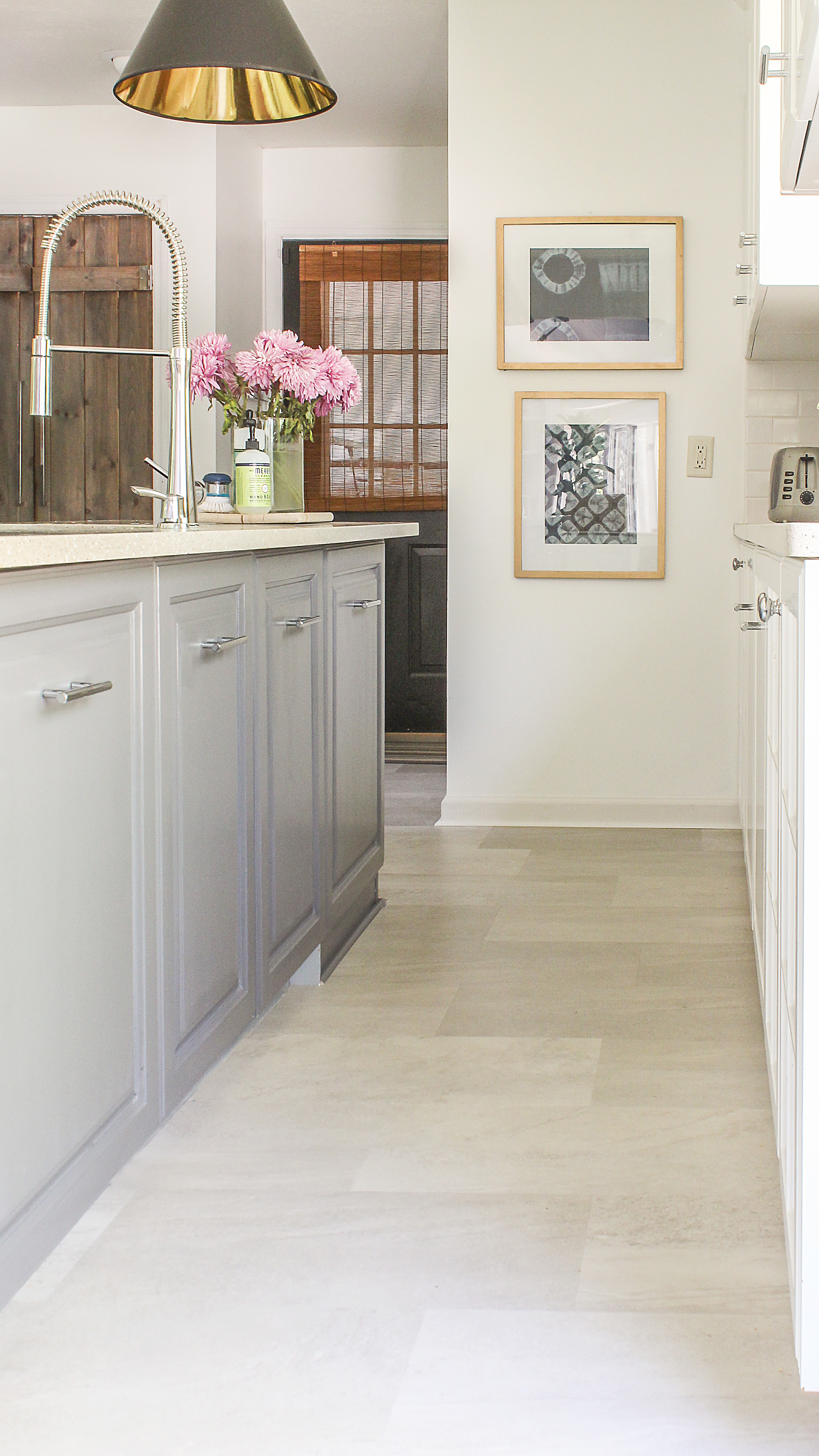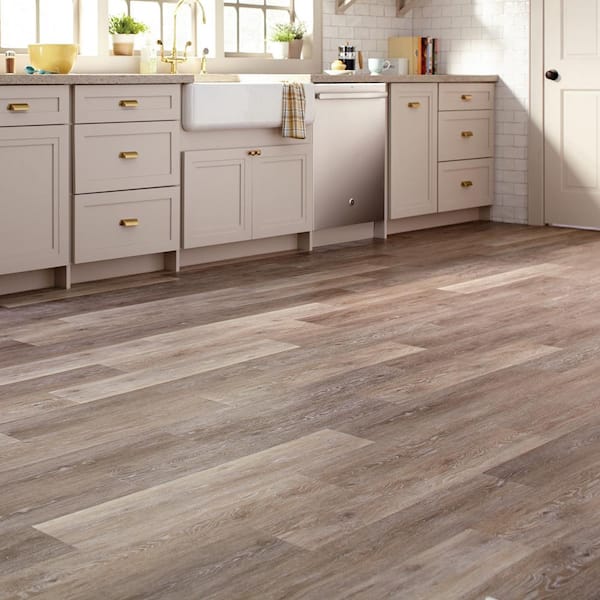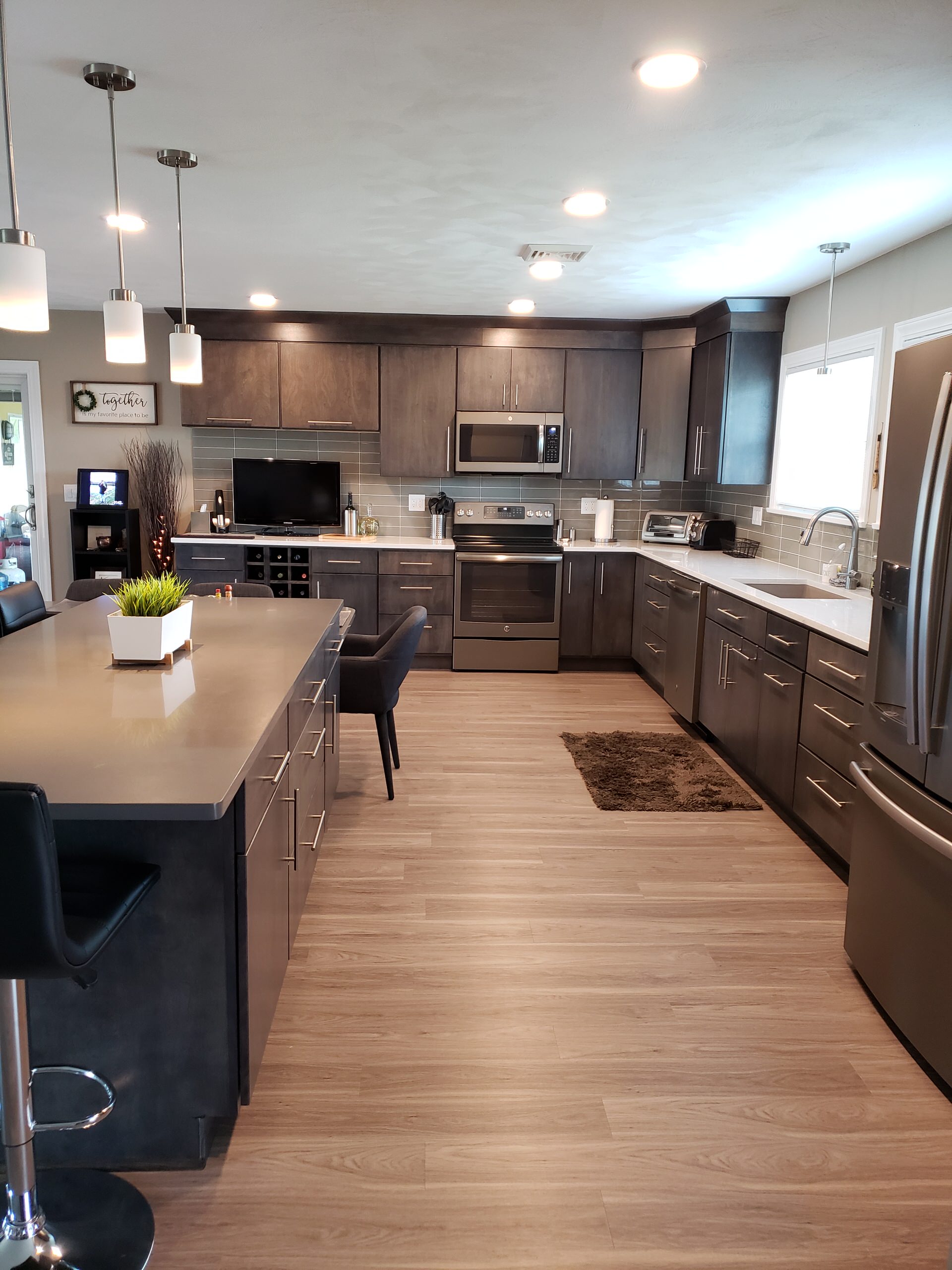Why Vinyl Flooring is Ideal for Kitchens
When it comes to kitchen flooring, vinyl is often one of the first materials homeowners consider, and for good reason. It offers a combination of practicality, durability, and style that makes it ideal for such a high-traffic, moisture-prone area. If you’re on the fence about what kind of flooring to use in your kitchen, vinyl should be on your list of options.
- Durability Kitchens see a lot of action—cooking, cleaning, spills, and constant foot traffic. Vinyl flooring is designed to handle it all. It’s highly resistant to scratches, dents, and stains, which makes it perfect for the daily wear and tear a kitchen endures. Plus, many vinyl floors come with a wear layer that further protects them from damage.
- Water Resistance One of the main concerns in kitchens is moisture. Vinyl flooring is inherently water-resistant, and in some cases, completely waterproof. Whether it’s a spill, a leaky dishwasher, or just mopping up after a cooking session, vinyl flooring can handle the moisture without warping or becoming damaged, making it far more durable than materials like hardwood.
- Comfort Underfoot Unlike ceramic or stone, vinyl offers a softer feel underfoot. This makes it more comfortable to stand on for long periods, which is especially helpful when cooking or cleaning. Some vinyl options even come with built-in underlayment, adding extra cushioning and sound absorption.
- Easy Maintenance Vinyl flooring is incredibly easy to maintain. Regular sweeping and occasional mopping are all that’s required to keep it looking as good as new. Stains can be wiped up easily, and it doesn’t need the frequent refinishing or sealing that other flooring types require.
- Affordable Yet Stylish Vinyl is a budget-friendly option that doesn’t sacrifice style. With advancements in manufacturing, vinyl can now mimic high-end materials like hardwood, stone, or tile, offering a luxury look without the luxury price tag.
- Versatile Installation Whether you’re doing a full kitchen renovation or just updating your floors, vinyl is easy to install in almost any kitchen setup. There are options for glue-down, peel-and-stick, or floating vinyl floors, making it a flexible choice for different installation needs.

Types of Vinyl Flooring for Kitchens: Plank, Tile, and Sheet
Vinyl flooring comes in several different forms, and each type has its own set of benefits depending on your kitchen’s needs and your personal preferences. Plank, tile, and sheet vinyl are the most common types, and each offers unique advantages in terms of aesthetics, installation, and performance.
Vinyl Plank Flooring Vinyl plank flooring is designed to mimic the look of hardwood. It comes in individual planks, which gives it a more realistic wood appearance compared to other types of vinyl. Planks are often preferred for kitchens because they offer a high-end look, with the added benefits of vinyl’s water resistance and durability. They’re typically installed as a floating floor, meaning they snap together and “float” above the subfloor without needing glue or nails.
Vinyl Tile Flooring Vinyl tiles are designed to resemble stone or ceramic tile but come at a fraction of the cost. They’re available in various sizes and patterns, allowing for customized designs. Like vinyl planks, tiles can be installed using a click-lock system, making it an easy DIY project. One major benefit of vinyl tiles is that if one becomes damaged, you can replace a single tile instead of the entire floor.
Sheet Vinyl Flooring Sheet vinyl is a continuous roll of flooring, typically 6 or 12 feet wide. It’s the most budget-friendly option and offers excellent moisture protection since there are fewer seams where water can seep in. Sheet vinyl is a great choice for kitchens that see heavy spills or moisture, as it provides a nearly seamless barrier.
Click-Lock Vinyl Both vinyl planks and tiles often come in click-lock versions, which make installation a breeze. The pieces simply snap together without the need for adhesives, which is especially useful in kitchens where precision is key due to cabinets and appliances.
Glue-Down Vinyl If you prefer a more permanent installation, glue-down vinyl is another option. It’s adhered directly to the subfloor, which can make it more stable in high-traffic areas like kitchens. This option is particularly useful in commercial kitchens or busy households that need extra durability.
Peel-and-Stick Vinyl For those looking for a quick, budget-friendly update, peel-and-stick vinyl tiles are ideal. They have adhesive backing, so you can simply peel off the paper and stick them to the floor. This makes them perfect for a DIY project, and they’re especially useful for small kitchens or areas like pantries.
Waterproof and Stain-Resistant Features of Vinyl Kitchen Floors
One of the biggest advantages of vinyl flooring in the kitchen is its waterproof and stain-resistant properties. Given how much water and food spills happen in a kitchen, these features make vinyl one of the most practical flooring choices.
100% Waterproof Vinyl Many modern vinyl floors, particularly luxury vinyl planks (LVP) and tiles (LVT), are 100% waterproof. This means that even in the event of a major leak, the floor won’t swell or warp like hardwood. Waterproof vinyl can be submerged in water and still retain its shape, making it perfect for kitchens that deal with frequent spills or moisture from cooking and cleaning.
Stain Resistance Vinyl’s top wear layer provides a barrier against stains, which is especially important in the kitchen where spills from oils, sauces, and other food are common. This protective layer ensures that most spills can be wiped up easily without leaving a lasting stain, making vinyl an ideal choice for families with children or frequent cooks.
Seamless Water Protection When installed correctly, especially in sheet vinyl forms, the seams between sections are minimal, providing excellent protection against water. This is particularly helpful in kitchens where water might pool around sinks, refrigerators, or dishwashers.
Scratch and Scuff Resistance In addition to its waterproof qualities, vinyl’s wear layer also protects it from scratches and scuffs caused by dragging chairs, dropping utensils, or moving heavy appliances. This makes it a practical option for kitchens, where heavy foot traffic and occasional mishaps are unavoidable.
Resistant to Mold and Mildew Kitchens, especially those with poor ventilation, can sometimes become breeding grounds for mold and mildew, especially if water spills are left unattended. Vinyl’s moisture-resistant properties help prevent the growth of mold and mildew, contributing to a healthier kitchen environment.
Long-Lasting Durability Because of these waterproof and stain-resistant qualities, vinyl floors tend to last a long time, even in high-moisture, high-traffic areas like kitchens. As a result, you can count on your vinyl kitchen flooring to stay beautiful and functional for years without needing frequent replacements or repairs.
Design Options: Mimicking Wood, Stone, and Tile in Vinyl
One of the most exciting aspects of choosing vinyl flooring for your kitchen is the wide range of design options available. Vinyl flooring has come a long way in terms of aesthetics, and it now offers an impressive variety of looks that can mimic more expensive materials like wood, stone, and tile.
Wood-Look Vinyl If you love the warmth and texture of hardwood but don’t want to deal with its high cost and maintenance, wood-look vinyl is a perfect alternative. Modern vinyl planks can replicate the appearance of oak, walnut, maple, and other wood types with incredible detail, even down to the grain patterns and textures. This allows you to achieve a rustic or elegant kitchen design without the worry of moisture damage that can affect real wood.
Stone-Look Vinyl Vinyl tiles and planks can also mimic the appearance of natural stone like marble, slate, and travertine. The advantage here is that vinyl is much more affordable and easier to maintain than real stone. Plus, you don’t have to worry about the cold, hard feel underfoot that stone can bring; vinyl is softer and more comfortable to stand on.
Tile-Look Vinyl For those who love the clean, classic look of ceramic or porcelain tile but want something softer and easier to install, tile-look vinyl is a great solution. Vinyl tiles can replicate the appearance of traditional tile patterns like hexagons, subway, or checkerboards, giving your kitchen a timeless look without the hassle of grout lines and cold surfaces.
Patterned Vinyl If you’re looking for something bold and unique, vinyl flooring also comes in a variety of patterns and designs that can add personality to your kitchen. From geometric shapes to vintage-inspired prints, you can find a vinyl option that reflects your style.
Textured Vinyl One of the reasons vinyl has become so popular is the advancement in its texturing. Modern vinyl can have a textured finish that mimics the feel of real materials. Whether you choose a wood-look plank with a hand-scraped texture or a stone-look tile with a rough, uneven surface, you can get the tactile experience of natural materials at a fraction of the cost.
Customizable Designs Some vinyl flooring allows for customization, especially when using peel-and-stick tiles. You can mix and match different colors and patterns to create your unique design, perfect for kitchens where you want to add a personal touch.
Vinyl Flooring Installation: DIY vs. Professional
One of the biggest advantages of vinyl flooring is that it’s relatively easy to install, making it an appealing option for both DIY enthusiasts and those who prefer to hire a professional. Whether you choose to install it yourself or hire a pro depends on your comfort level, time, and budget.
DIY Installation Many vinyl flooring options, such as peel-and-stick tiles and click-lock planks, are designed with DIY installation in mind. These types of vinyl don’t require special tools or adhesives, making them ideal for homeowners who want to tackle the project themselves. Installing vinyl as a DIY project can save you a significant amount of money on labor costs, which is a big draw for budget-conscious homeowners.
Ease of Installation Vinyl flooring is known for its ease of installation, especially when compared to more complicated materials like ceramic tile or hardwood. Most vinyl floors can be installed directly over existing floors, such as tile or linoleum, as long as the surface is clean and level. This makes it a quick and convenient option for kitchen renovations.
Click-Lock vs. Glue-Down There are two main types of vinyl installation: click-lock and glue-down. Click-lock vinyl is the easiest to install because the planks or tiles simply snap together without the need for adhesives. This method is perfect for DIYers. Glue-down vinyl, on the other hand, requires adhesive and more precision, so it might be better suited for professional installation.
Hiring a Professional If you’re not confident in your ability to install the flooring yourself, or if your kitchen has complex layouts or obstacles like islands, hiring a professional might be the better option. Professional installers will ensure that the flooring is laid perfectly, with no gaps or uneven edges. While it costs more upfront, it can save you time and the hassle of fixing potential mistakes later on.
Installation Time One of the benefits of vinyl flooring, whether installed DIY or professionally, is how quickly it can be completed. A simple kitchen can be fully installed with vinyl flooring in just a day or two, making it a much faster option than tile or hardwood, which can take several days or even weeks.
Cost Considerations DIY installation is, of course, more cost-effective, as you won’t need to pay for labor. However, professional installation ensures a flawless finish, which could save you money in the long run by avoiding potential repairs or mistakes. When weighing your options, consider your own DIY skills, the complexity of your kitchen’s layout, and your overall budget.
Maintenance Tips for Keeping Your Vinyl Kitchen Floor Looking New
One of the reasons vinyl flooring is so popular in kitchens is that it’s incredibly easy to maintain. With just a few simple steps, you can keep your vinyl floor looking fresh and clean for years to come. Here are some maintenance tips to ensure your vinyl kitchen floor stays in top condition.
Regular Sweeping One of the easiest ways to maintain your vinyl flooring is by sweeping it regularly. Dirt and debris can scratch the surface of the floor over time, especially if it’s dragged around by foot traffic. A quick daily sweep can prevent this, keeping the floor looking smooth and new.
Mopping as Needed For deeper cleaning, mopping your vinyl floor is essential. Use a damp mop with a mild cleaner specifically designed for vinyl floors. Avoid soaking the floor with too much water, as this can seep into the seams and cause issues over time. Stick to a gentle cleaner, as harsh chemicals can strip away the protective wear layer on vinyl.
Spot Cleaning Spills Kitchens are prone to spills, and while vinyl is highly resistant to stains, it’s still a good idea to clean up messes as soon as they happen. This prevents any residue from setting in and keeps your floor looking pristine. Most spills can be cleaned up with just water or a mild cleaner.
Using Furniture Pads To protect your vinyl floor from scratches, place felt or rubber pads under the legs of kitchen chairs, tables, and any other furniture. Vinyl is durable, but heavy or sharp furniture can still cause indentations or scratches if not properly protected.
Avoid Dragging Heavy Objects If you need to move large appliances or furniture across your vinyl floor, always lift them instead of dragging them. Dragging heavy objects can gouge or tear the vinyl. If lifting isn’t an option, place a protective barrier like plywood or cardboard under the object and slide it carefully.
Avoid Harsh Cleaners While vinyl is low maintenance, it’s important to use the right cleaning products. Avoid abrasive scrubbers, waxes, and harsh chemicals like ammonia or bleach, as these can damage the vinyl’s surface. Instead, opt for cleaners specifically formulated for vinyl floors to preserve their shine and protective layer.
Cost-Effectiveness of Vinyl Flooring: Budget-Friendly Kitchen Upgrade
Vinyl flooring has long been known as one of the most cost-effective flooring options available, and when it comes to kitchens, it’s hard to beat in terms of value. Not only is vinyl affordable upfront, but it also offers long-term savings due to its durability and low maintenance requirements.
Affordable Material Vinyl is one of the most affordable flooring materials on the market. Whether you opt for vinyl planks, tiles, or sheets, the cost per square foot is often much lower than other flooring options like hardwood, tile, or stone. This makes it an excellent choice for homeowners looking to update their kitchen without breaking the bank.
Low Installation Costs Vinyl is relatively easy to install, which means that installation costs are typically lower than with other flooring types. DIY installation can save you even more money, but even if you hire a professional, the overall cost will still be lower than with materials that require more labor-intensive installation, like tile or hardwood.
Durability Equals Long-Term Savings One of the biggest advantages of vinyl is its durability. Vinyl flooring can last for 10 to 20 years or more with proper care, which means you won’t need to replace it as often as other flooring types. Its resistance to water, stains, and wear makes it a great investment for a high-traffic area like the kitchen.
Energy Efficiency Vinyl flooring also has some energy-saving benefits. It provides a layer of insulation, which can help keep your kitchen warmer in the winter and cooler in the summer. This can potentially lower your heating and cooling costs, making it a cost-effective option in more ways than one.
Minimal Maintenance Costs Because vinyl is so easy to maintain, you’ll save on cleaning and repair costs over the life of the floor. You won’t need to buy expensive cleaners or sealants, and because it’s resistant to scratches and stains, you’re less likely to need professional repairs or refinishing.
Versatility in Style Without the Price Tag Vinyl’s ability to mimic high-end materials like wood, stone, and tile means you can achieve a luxurious look in your kitchen without paying for the real thing. This allows you to get the aesthetic you want at a fraction of the cost, making vinyl an ideal choice for budget-conscious homeowners who don’t want to compromise on style.
Vinyl Floor Kitchen Ideas
Everything you need to know about Vinyl flooring Tarkett
Related Posts:






